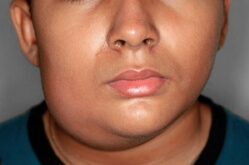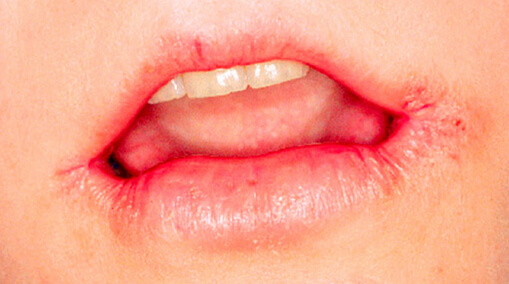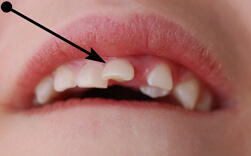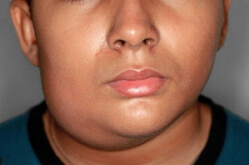Periostitis of the lower jaw
 Periostitis of the lower jaw is a surgical pathology with very dangerous outcomes in its progression. It should be noted that such pathologies require the intervention of the facial and jaw surgeon and dentist. Periostitis of the lower jaw is dangerous even without the slightest complications, but all the negative it will manifest in the formation of surgical complications that reach the sepsis. I also want to note that periostitis of the lower jaw rarely occurs spontaneously and independently, mostly it progresses from less severe pathologies, often with caries.
Periostitis of the lower jaw is a surgical pathology with very dangerous outcomes in its progression. It should be noted that such pathologies require the intervention of the facial and jaw surgeon and dentist. Periostitis of the lower jaw is dangerous even without the slightest complications, but all the negative it will manifest in the formation of surgical complications that reach the sepsis. I also want to note that periostitis of the lower jaw rarely occurs spontaneously and independently, mostly it progresses from less severe pathologies, often with caries.
If to speak "in simple language", the periostitis is a flux, which is its synonym and denotes the rapid spread of pathology. The process, which has a purulent content, actively spreads through the periosteum.
Periostitis of the lower jaw: causes
All surgical pathologies, and periostitis of the lower jaw are no exception, have an etiology of bacterial. That is, for suppuration, microorganisms and a macroorganism with sufficient immunity are needed to form a reaction. Basically, the etiology of such jaw processes is a gram-positive flora, that is, streptococci and staphylococci. And although the cause is always microbial, but the way of getting is also important.
Primary and most common odontogenic path, when the progression of pathology proceeds from a certain tooth, then to the root, and from there to the periosteum. The hematogenous pathway is associated with blood spreading, this signals if somewhere in the body there is a foci of infection, that is, the risk of the presence of bacteria from one bacterial focus throughout the body, especially when the immune system falls, including the periosteum of the mandibular bone. The lymphogenous method is similar to hematogenous. These ways are in children after suffering from staphylococcal diseases, such as tonsillitis, tonsillitis, otitis, scarlet fever. All of them have a common pathogen beta-hemolytic streptococcus group A. In addition, the development of the disease can lead to complications of influenza, measles and similar childhood illnesses. Distribution occurs through the lymphatic capillaries, which drain a certain area. Traumatic pathology occurs with massive injuries, when open injuries and fractures of the lower jaw lead to infection directly to the periosteum and disrupt the immune system. Dental ablation and surgical interventions are also capable of leading to similar kinds of problems.
The most common cause of periostitis of the lower jaw still occurs from the teeth, with many diseases capable of leading to similar results, but this requires a decrease in immunity, hypothermia and similar conditions.
Often such a pathology progresses periodontitis of the lower jaw, especially its chronic forms. This result can lead to alveolitis, inflammation of the wisdom teeth, especially in the absence of their sanation, suppurating cysts, which often do not betray themselves. The mechanism in this case consists of a passage through the bone channels, and already falling under the periosteum, develops into a pathological process, passing from a compact and spongy layer of the jaw. This disease can provoke even some gum disease, in particular periodontitis.
Posteritis of the lower jaw: symptoms of
Symptoms are very diverse and vary from species and location. The most typical local manifestations, especially the symptoms of inflammation. To them belongs swelling, which strongly bursts into its size the damaged part of the jaw. Always in cases with periostitis of the lower jaw, redness is noticeable, which changes the color of the tissues surrounding the lesion. Also, local characteristic changes in the form of a decrease in the function performed by this body. In the case of periostitis, it is the difficulty of chewing and the complexity of speech. Characteristic is also acute pain and an increase in local temperature, according to the type of heat.
Serous periostitis of the lower jaw is characterized by more local aforementioned manifestations, as well as regional lymphadenitis with inflammation of the lymph nodes and lymphostasis. Mucous is especially hyperemic in the area of the fold of the mouth. When examining the oropharynx and its cavity, a tooth is found that has periodontitis or pulpitis.
Purulent periostitis of the lower jaw in addition to local problems also has a common symptomatology, in particular: fever, even to febrile digits, general malaise, intoxication. A purulent periostitis of the tender jaw often occurs with osteomyelitis with the same lesion of the lower jaw. Purulent periostitis of the lower jaw is described by a change in the localization of pain, in the region of the entire lower part of the face. There is also shooting echopodobnaya pain in the ears, in the temples and in the neck. Often unbearable pain in the head is troubled, especially when opening the mouth. Movement is severely limited, but in the damaged tooth there is pathological mobility. In cases, even the eye socket itself can be more difficult to hurt. The facial features vary greatly and are distorted, you can detect a significant swelling of the face. The edema is more likely located on the lower lip, large enough, and on the chin.
The periostitis of the lower jaw has characteristic changes, they are localized from the internal mucosa of the jaw, a dense solid conglomerate that can later become mild is characteristic, and a considerable swelling is observed. As a complication, it is possible for the exudate to flow under the mucous membranes of the gum itself, which leads to submucosal abscesses with fistula formation. If all this occurs in the mouth, it leads to a temporary decline in edema. There is a feeling of deceitful relief, but in truth the situation only progressively worsens. Mucous on the side of the mouth often becomes cyanotic, that is, it becomes blue due to the excessive plethora of venous etiology.
There is a danger of forming sepsis and similar acute life-threatening complications requiring massive antibiotic therapy.
Acute periostitis of the lower jaw
Acute periostitis of the lower jaw has acute causes and appears very quickly. Characterized by severe malaise and fever. It has several subspecies. Serous with less severe form of manifestation and giving fewer complications. The outcome of such forms is very favorable, since there is still no general response of the organism to the whole set of pathogenic flora. In the periosteum, infiltration occurs, which is clinically manifested in edema, local inflammation with redness and complication of the mandible. It should be noted that a small amount of serous exudate is found in the source of infection.
Periostitis of the mandible μB has its own classification and refers to the inflammatory pathologies of the jaw. Periostitis of the lower jaw, μB 10 has the number K 10.2 and is found in a wide group of pathologies of the digestive organs.
Purulent periostitis also has a sharp shape and its root causes. Microflora in this pathology is variable, mostly gram-positive aerobic, that is, oxygen-dependent flora, but more often still in this area an anaerobic infection penetrates, which gives much dangerous consequences. Since the mouth is one of the dirtiest places in a person, the microflora in it is diverse and there are even putrefactive bacteria and various sticks. Periostitis with purulent complications is accompanied by the appearance of an abscess, which in this case is called a flux. It is limited and belongs to the subnature species. Later, from this abscess fistulas are formed from which the purulent contents are evacuated to the outside.
Chronic periostitis of the lower jaw
Chronic forms differ in their variety. Periostitis of the lower jaw, the code for μb 10 in chronic form is number 10.23.Due to significant painful sensations, only a small number of people are able to tolerate and bring themselves to a chronic form. Most people go to the doctor and get treatment in the acute stage. But, if some results of treatment did not lead to the desired outcome, it is possible to form insidious chronic forms.
Chronic periostitis of the lower jaw differs in diversity and more latent implicit symptoms. But from this he does not become less dangerous. A simple and most common form has a current with periodic exacerbations. The jaw sometimes swells and hurts, and then again stops for a while. The pain is periodic, localized in the area of the tooth itself. At the same time, lymph nodes are often hypertrophied, and the mucous membrane on the side of the mouth is cyanotic and edematic.
Ossifying the periostitis of the lower jaw also leads to serious consequences. There is a deformation of the jaw, a young tissue of bone origin is synthesized in the periosteum. This is due to a flaccid, but still flowing inflammation, which stimulates osteogenesis. In a simple form, such consequences are also observed, but they are reversible. And in this case, ossification is rapidly progressing, while the bone tissue is not reversible, because there is hyperostosis and ossification. The facial features vary considerably, becausePart of the jaw, struck by hyperosification, significantly thickens.
It should be remembered that for the transition of purulent infections into chronic ones there must be reasons. It can be an immunodeficiency of various genesis and etiology;with poor treatment when periostitis mandible not properly drained and thickening valikopodobnom accumulated purulent exudate. In the case of immunodeficiencies, acute periostitis may not be present. Chronic periostitis occurs with periodic remissions and impairments and is detected already on the x-ray. Characteristic of chronic lymph node enlargement without severe pain. There is also a fibrous form, but it is quite rare.
Periostitis mandible: Treatment
This pathology can be successfully treated and can achieve full recovery with the right approach. In the serous stage, it is possible to manage conservative therapy, and subsequently a surgical incision is performed.
No doubt such pathology better profilaktirovat conducting sanitation mouth and turning to the dentist with the slightest problems. Dental channels can be cleaned of pus and other types of exudate. It is obligatory to conduct anesthesia, since without this it is difficult to carry out these manipulations. Sometimes it is enough infiltration with the cutting of a painful place, and sometimes conductive. It is important to consider that the mucosa is anesthetized, but not the area of suppuration. If there is a purulent focus with a leukocyte roller around, a cut is made with drainage. It is very important to rinse antiseptics after opening. Suitable for Chlorhexedin, Tantum Verde, Furacillin, Decametoxin. In some cases, tooth extraction is possible. Removal naturally facilitates further care, but considering the prospects, try to treat without such radical measures, simply courting more thoroughly.
Many methods of physiotherapy are used in the recovery phase. Very effective UHF, which stimulates healing, laser therapy, rosehip oil, sea buckthorn, camphor. Rinsing with antiseptics is not excluded.
Antibiotics for periostitis of the lower jaw are used without hesitation, since they have a decisive influence on the pathogenic microflora. They are selected individually by determining the strain of infection during sowing. Many groups are effective, but it is important to take into account the duration of admission to prevent antibiotic resistance, as well as allergic anamnesis. Apply different groups: Flemoklav, Ampisulbin, Sulbaktamaks, Amoxiclav, Amoxil, Tsiprolet, ciprofloxacin, vancomycin, clarithromycin, ceftriaxone, azithromycin, levofloxacin, ceftazidime, lincomycin, Metragil. Suitable nitrofurans, particularly furazolidone, furadonin as antiseptics, as well as sulfonamides: Norsulfazol, Sulfodemetoksin. It is also used antihistamines to prevent swelling and relieving allergic component: Diazolin, loratadine, Suprastin, Tsetrilev, diphenhydramine, Tsetrin. Preparations with calcium and vitamin complexes are effective for the subsequent accompaniment of the patient.
The periostitis of the lower jaw has some features of surgical treatment, a scalpel of sickle structure is used. The incision is also performed along the inner surface of the mandible branch. The incision is made up to the bone along several molars. Soft tissues are peeled off with a rasper to prevent damage to the chewing muscles. Drainage is left and washed daily and observed. Dental ointments and gels are also used, especially effective with plant extracts.



